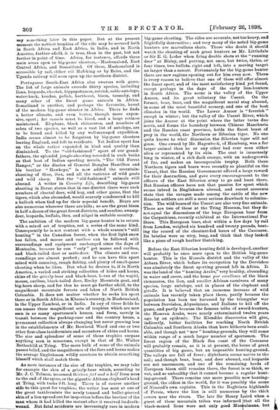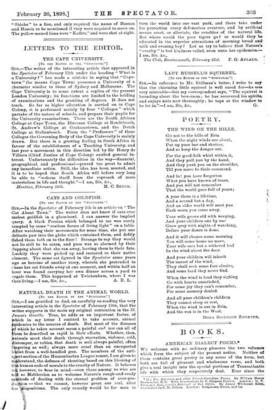BIG GAME.
ACIRCULAR is now being issued to sportsmen, inviting them to join in a big-game shooting expedition to British East Africa. The particular district selected as a hunting ground is that round Mount Kenia, the route being yid. Mombasa and the Uganda railway. The advertised cost for twelve months is £300, which leaves rather a narrow margin for contingencies, and of the big game which figure among the probable bag, one, the quagga, is extinct, and another, the spring-buck, is not found north of the Zambesi. But there is no doubt whatever that in spite of the decrease of most big game in its old haunts, there is in Cape Colony, the Transvaal, Natal, the Northern States of America, and some parts of Arctic Europe, notably in Spitzbergen, abundance of sport left, and sport of the finest kind, acces- sible at a moderate cost, and with no great loss of time on the journey. Of the hunting-grounds of the future we ACIRCULAR is now being issued to sportsmen, inviting them to join in a big-game shooting expedition to British East Africa. The particular district selected as a hunting ground is that round Mount Kenia, the route being yid. Mombasa and the Uganda railway. The advertised cost for twelve months is £300, which leaves rather a narrow margin for contingencies, and of the big game which figure among the probable bag, one, the quagga, is extinct, and another, the spring-buck, is not found north of the Zambesi. But there is no doubt whatever that in spite of the decrease of most big game in its old haunts, there is in Cape Colony, the Transvaal, Natal, the Northern States of America, and some parts of Arctic Europe, notably in Spitzbergen, abundance of sport left, and sport of the finest kind, acces- sible at a moderate cost, and with no great loss of time on the journey. Of the hunting-grounds of the future we
say something later in this paper. But at the present moment the noblest trophies of the rifle may be secured both in South Africa and East Africa, in India, and in North America, further afield, it is true, than in the past, but not further in point of time. Africa, for instance, affords three main areas open to big-game shooters,—Mashonaland, East Central Africa, and Somaliland. Of these, Mashonaland is accessible by rail, either vid Mafeking or by Beira, and the Uganda railway will soon open up the northern district.
Portuguese South-East Africa also swarms with game. The list of large animals exceeds thirty species, including lions, leopards, cheetah, hippopotamus, ostrich, sable-antelope, water-buck, koodoo, pallah, hartbeest, bison, tsesseby, and many other of the finest game animals in Africa.
Somaliland is another, and perhaps the favourite, haunt of the modern big-game shooter in Africa. There he finds a hotter climate, and even better, though more expen- sive, sport ; for camels must be hired, and a large retinue maintained. Elephant, black rhinoceros, and numbers of zebra of two species, as well as a vast list of antelope, are to be found and killed by any well-managed expedition.
India seems almost to be forgotten by big-game shooters leaving England, and left to residents. Yet Indian sport has on the whole rather expanded in kind and quality than diminished. To the " old-fashioned " sport of our grand- fathers, the splendid jungle-shooting recorded in such books as that best of Indian sporting novels, "The Old Forest Ranger," or the diaries of General Douglas Hamilton and his brother " Hawkeye," is now added the mountain- shooting of thur, ibex, and all the varieties of wild goats and wild sheep. But the " old-fashioned " animals still abound. A writer in Country Life, describing big-game shooting in Berar, states that in one district there were such numbers of cheetul deer, wild hog, and other game, that the tigers, which also abounded, would scarcely condescend to kill a bullock when tied up for their especial benefit. Bears are also numerous wherever there are hills ; so are the great bison in half a dozen of the great forest districts, and sambur, swamp- deer, leopards, buffalo, ibex, and nilgai in suitable country.
The ambition of the modern big-game hunter is to return with a mixed set of trophies, not a series of the same kind. Consequently he is not content with a whole season's "still hunting" in the Canadian forest, when the first light snow has fallen, and moose and cariboo can be followed with surroundings and equipment unchanged since the days of Montcalm, because he can "only" get moose and cariboo, and black-tailed deer or mule-deer. The climate and sur- roundings are almost perfect ; and he can have this sport mixed with canoeing, rough fishing, and plenty of small-game shooting when he likes. But what be desires is, if in North America, a varied and striking collection of hides and horns, skins of the grizzly-bear and black-bear, horns of the wapiti, moose, cariboo, black-tailed deer, Rocky Mountain goat, and big-horn sheep, and for this he must go further afield, to the magnificent mountain forests and lakes cf North British Columbia. It does not matter whether he seeks his sport there or in South Africa, in Khama's country, in Masbonaland, in the Upper Zambesi, or in India. In any of these fields he can amass those magnificent sets of trophies which are now seen in so many sportsmen's homes, and form, merely in transit between the packing-case and the country house, a permanent collection always changing but never growing less in the establishments of Mr. Rowland Ward and one or two other first-class taxidermists and mounters of skins and horns. The size and splendour of some of these trophies surpass anything seen in museums, except in that of Mr. Walter Rothschild at Tring. The mere bulk of some of the animals passes belief, and the magnificence of the furs and horns makes the average Englishman wildly covetous to obtain something himself which shall match them.
As mere instances of the size of the trophies, we may take for example the skin of a grizzly-bear which, according to Mr. J. C. Tolman, measured thirteen feet and a half from nose to the end of the spine, or the gigantic African elephant's head at Tring, with tusks 9 ft. long. There is of course another aide to this quest for trophies; the writer has seen at one of the great taxidermists the newly tanned and bullet-pierced akin of a lion spread out for inspection before the brother of the man whom it had killed the instant after it received its death- wound. But fatal accidents are increasingly rare in modern
big-game shooting. The rifles are accurate, not too heavy, an& frightfully destructive ; and very many of the noted big-game hunters are marvellous shots. Those who doubt it should watch the shooting of such great hunters as Mr. Littledale or Sir E. G. Loder when firing double shots at the "running deer" at Bisley, and putting, not once, but twice, thrice, or four times, two bullets, right and left, into a moving target no larger than a saucer. Fortunately for the big-game hunter there are new regions opening out for him even now. There- is every reason to believe that one of these will offer almost the finest sport, and of the most satisfactory kind yet found, except perhaps in the days of the early lion-bunters- in South Africa. The scene is the valley of the Upper Amoor, and its great tributary the Ussuri. On the former, bear, boar, and the magnificent maral stag abound, in some of the most beautiful scenery, and one of the best climates in the world. The Lower Amoor is "feverish "- except in winter; but the valley of the Ussuri River, which joins the Amoor at the point where the latter turns due- north, and forms the boundary between Chinese Manchuria and the Russian coast province, holds the finest beast of prey in the world, the Northern or Siberian tiger. No one quite knows to what dimension the Siberian tiger will not grow. One owned by Mr. Hagenbeok, of Hamburg, was a far larger animal than he or any other had ever seen either alive or represented by its skin. The coat is immensely long in winter, of a rich dark orange, with an undergrowth of fur, and makes an incomparable trophy. Both these Northern tigers and bears were recently so plentiful on the- Ussuri, that the Russian Government offered a large reward for their destruction, and gave every encouragement to the- officers of the East Siberian army to go and hunt there. But Russian officers have not that passion for sport which• seems inbred in Englishmen abroad, and recent accounts.
state that the ravages made among the cattle of the new Russian settlers are still a most serious drawback to colonisa- tion. The wild boars of the Ussuri are also very fine animals.
There are two of these at the Tring Museum, but they do- not equal the dimensions of the huge European boar from the Carpathians, recently exhibited at the International Fur Store. This European boar, shot within a few days by rail from London, weighed six hundred and twenty pounds, beat- ing the record of the chestnut-fed boars of the Caucasus._ Its bristles were so wiry, long, and thick that they looked- like a piece of rough heather thatching.
Before the East Siberian bunting field is developed, another will probably be once more open to the British big-game hunter. This is the Kassala district and the valley of the Atbara River, which before its occupation by the Dervishes' was absolutely the finest sporting ground left in Africa. It. was the land of the " hunting Arabs," very healthy, abounding in water and cover, and the home par excellence of the black rhinoceros, the lion, and smaller African carnivore of many species, large antelope, and in places of the elephant and giraffe. It is believed that an immense increase of wild animals has recently taken place there, partly because the population has been too harassed by the triangular war between Dervishes, Abyssinians, and Italians to kill off the game, and partly because the famous tribe of sword-hunters, the Hamran Arabs, were nearly exterminated twelve years ago by an epidemic. The Klondike discoveries will give, indirectly, better facilities for reaching North British Columbia and Southern Alaska than have hitherto been avail- able, and though not " new " hunting-grounds, they will come within range of a much larger number of sportsmen. The forest region of the Black Sea coast of the Caucasus will probably remain, as it is at present, the home of great. quantities of big game, but an impossible hunting-ground. The valleys are full of fever; diphtheria seems native to the soil ; and though bear, boar, and deer abound, and leopards are not uncommon, and one of the remaining herds of European bison still remains there, the forest is so thick, so wet, and so unhealthy that it cannot become a regular hunt- ing-ground. There remains one more possible new hunting- ground, the oldest in the world, for it was possibly the scene of Nimrod's own exploits. This is the Baghtiara highlands of Persia, where the lion is still numerous by the thick covers near the rivers. The late Sir Henry ird when a guest of these mountain tribes was informed hat all the, black-maned lions were not only good M ulmana. but.
"Shiahs " to a lion, and only required the name of Hassan and Hosein to be mentioned if they were required to move on. The yellow-maned lions were " Kaffirs," and were shot at sight.








































 Previous page
Previous page